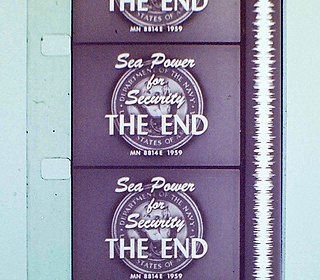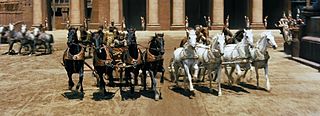Related Research Articles

16 mm film is a historically popular and economical gauge of film. 16 mm refers to the width of the film ; other common film gauges include 8 mm and 35 mm. It is generally used for non-theatrical film-making, or for low-budget motion pictures. It also existed as a popular amateur or home movie-making format for several decades, alongside 8 mm film and later Super 8 film. Eastman Kodak released the first 16 mm "outfit" in 1923, consisting of a camera, projector, tripod, screen and splicer, for US$335. RCA-Victor introduced a 16 mm sound movie projector in 1932, and developed an optical sound-on-film 16 mm camera, released in 1935.
IMAX is a proprietary system of high-resolution cameras, film formats, film projectors, and theaters known for having very large screens with a tall aspect ratio and steep stadium seating, with the 1.43:1 ratio format being available only in few selected locations.

Cinematography is the art of motion picture photography.

The New Wave, also called the French New Wave, is a French art film movement that emerged in the late 1950s. The movement was characterized by its rejection of traditional filmmaking conventions in favor of experimentation and a spirit of iconoclasm. New Wave filmmakers explored new approaches to editing, visual style, and narrative, as well as engagement with the social and political upheavals of the era, often making use of irony or exploring existential themes. The New Wave is often considered one of the most influential movements in the history of cinema.

Panavision Inc. is an American motion picture equipment company founded in 1954 specializing in cameras and lenses, based in Woodland Hills, California. Formed by Robert Gottschalk as a small partnership to create anamorphic projection lenses during the widescreen boom in the 1950s, Panavision expanded its product lines to meet the demands of modern filmmakers. The company introduced its first products in 1954. Originally a provider of CinemaScope accessories, the company's line of anamorphic widescreen lenses soon became the industry leader. In 1972, Panavision helped revolutionize filmmaking with the lightweight Panaflex 35 mm movie camera. The company has introduced other cameras such as the Millennium XL (1999) and the digital video Genesis (2004).

France competed at the 1976 Summer Olympics in Montreal, Quebec, Canada. 206 competitors, 177 men and 29 women, took part in 128 events in 18 sports.

Albert Maysles and his brother David Maysles were an American documentary filmmaking team known for their work in the Direct Cinema style. Their best-known films include Salesman (1969), Gimme Shelter (1970) and Grey Gardens (1975).

High-speed photography is the science of taking pictures of very fast phenomena. In 1948, the Society of Motion Picture and Television Engineers (SMPTE) defined high-speed photography as any set of photographs captured by a camera capable of 69 frames per second or greater, and of at least three consecutive frames. High-speed photography can be considered to be the opposite of time-lapse photography.
Super Panavision 70 is the marketing brand name used to identify movies photographed with Panavision 70 mm spherical optics between 1959 and 1983. It has since been replaced by Panavision System 65.

Ultra Panavision 70 and MGM Camera 65 were, from 1957 to 1966, the marketing brands that identified motion pictures photographed with Panavision's anamorphic movie camera lenses on 65 mm film. Ultra Panavision 70 and MGM Camera 65 were shot at 24 frames per second (fps) using anamorphic camera lenses. Ultra Panavision 70 and MGM Camera 65's anamorphic lenses compressed the image 1.25 times, yielding an extremely wide aspect ratio of 2.76:1.
1:42.08 is George Lucas's senior project at the University of Southern California in 1966. It was named for the lap time of the Lotus 23 race car that was the subject of the film.

Anamorphic format is the cinematography technique of shooting a widescreen picture on standard 35 mm film or other visual recording media with a non-widescreen native aspect ratio. It also refers to the projection format in which a distorted image is "stretched" by an anamorphic projection lens to recreate the original aspect ratio on the viewing screen.
Jean-Claude Labrecque, was a director and cinematographer who learned the basics of filmmaking at the National Film Board of Canada.
Tony Ianzelo is a Canadian documentary director and cinematographer.
Articles related to the field of motion pictures include:
Jean Beaudin was a Canadian film director and screenwriter. He directed 20 films since 1969. His film J.A. Martin Photographer, was entered into the 1977 Cannes Film Festival, where Monique Mercure won the award for Best Actress. The film also won best Film, he won best Director, and Mercure won best Actress awards at the 1977 Canadian Film Awards. He was nominated for the Genie Award for Best Achievement in Direction in 1986, 1992 and 2003 for his films The Alley Cat , Being at Home with Claude and The Collector , respectively.
Georges Dufaux was a Canadian documentary film director and cinematographer.

Frances Ha is a 2012 American black-and-white comedy-drama film directed by Noah Baumbach. It is written by Baumbach and Greta Gerwig, who also stars as Frances Halladay, a struggling 27-year-old dancer. The film premiered at the Telluride Film Festival on September 1, 2012, and was given a limited theatrical release in the United States on May 17, 2013, by IFC Films.
The Years of Dreams and Revolt is a Canadian drama film, directed by Jean-Claude Labrecque and released in 1984. A sequel to his 1975 film The Vultures , the film revisits the story of Louis Pelletier in the 1960s, from the time of his wedding to Claudette in 1963 through to the time of the October Crisis in 1970.
André Mathieu, musicien is a Canadian documentary film, directed by Jean-Claude Labrecque and released in 1993. The film is a portrait of Canadian classical pianist and composer André Mathieu.
References
- ↑ Morris, Peter (1984). The Film Companion . Toronto: Irwin Publishing. p. 277. ISBN 0-7725-1505-0.
- ↑ Alioff, Maurie (November 2009). "Delinquent Days: An Interview with a Quebec icon, Cinematographer/Director/Scenarist Jean-Claude Labrecque csc". Canadian Cinematographer: 6–11.
- ↑ "Jean-Claude Labrecque". Take One. 1 (2): 13–14. November 1966.
- ↑ Smith, Jim (2003). George Lucas. Virgin Books. p. 12. ISBN 9780753507551 . Retrieved 30 April 2017.
- ↑ Wise, Wyndham (2001). Take One's Essential Guide to Canadian Film. Toronto: University of Toronto Press. p. 260. ISBN 0-8020-3512-4 . Retrieved May 1, 2017.